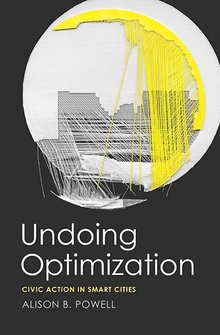Undoing Optimization
Alison B. Powell—
The smart city isn’t new. For at least the past two decades, new communication technologies have been imagined, marketed, and constructed to improve the function and experience of urban life. Let’s revisit the smart city of the late 1990s and early 2000s, when access to internet technologies was an important part of how smartness was imagined.
In many places in the world, governments and companies proposed projects to expand access to the internet. Often the entities pursuing these projects argued that expanded access to communication resources would lead to an expanded capacity for participation in civic life. Enthusiasm for projects like the Blacksburg Electronic Village—which aimed in the late 1990s to give the entire population of the town of Blacksburg, Virginia, access to the internet—turned on the idea that networked information systems could enhance participationin local decision-making and strengthen the ties between people through the benefit of enhanced connectivity to an information network.
Of course, the actual experience for the beneficiaries of this expanded communications access departed from the vision. The early 2000s visions of internet-based democratization of civic action paralleled other visions of augmented cities as ideal sites of expanded connectivity. Both ideas connected with struggles over communication rights but also opened space for information technology (IT) or information and communication technology (ICT) companies to market various internet access technologies as pillars of urban smartness. Governments, companies, and activists defined—as well as created—different capacities within the idea of the smart city. The proposals wove together a promise of a particular kind of “technological sublime” that, in the early 1990s, referred to a networked set of relationships modeled on the real and imagined capacities of networks of internet access. Social theorist Leo Marx and communication scholar Vincent Mosco both identify the idea of a technological (or digital) sublime as a major mythology connected with the power and influence of technology.Mosco argues that in order to judge the power of information technology we must also take account of the influence of major mythologies associated with it. The visions of smart cities derive from a myth about technology in general and optimization of civic life in particular. In practice, these kinds of visions developed through the language used in marketing by technology companies and in the investments that followed. They have echoes in public policy and in projects undertaken by technology activists and advocates, who often use the same discourses and the same technical materials to develop critical alternatives to the industrial visions for smart cities. This particular techno-systems thinking sets up expectations for the role of computer networks and internet access in cities.
Information, Superhighways, Connected Citizens, and 1990s Smart Cities
Beginning in the mid-1990s, scholars began to understand the global city as a communication nexus. Global connections through the internet intensified the capital and influence of global cities, and flows of people produced different global citizen experiences, including experiences of cities. A way of describing how technological modes of thinking influenced experiences of urban space was the notion that connectivity created a separation of global “spaces of flows” and local “spaces of places” bounded by local experience. This distinction seems, in retrospect, too rigid to account for the ways that people, rich and poor, moved into and between cities in this period and produced new forms of citizenship related to changes in economic status. The new economic relationships encouraged rights claims but also created new sites of civic struggle as migrant labor and transnational capital clashed. They also made the terrain of communication one of the sites of social struggle.
As claims for communication rights expanded, the result was a sense that within global cities, citizenship involved “more than rights to participate in politics. It could also include other kinds of rights in the public sphere, namely, civil, socio-economic, and cultural.” In this more expansive but contested space for claiming rights, global and transnational linkages inspired by the promise of better internet connectivity were viewed as ways to develop new citizenships.This view took the extreme form of claims that the institutional and cultural rigidities of the city might be liquefied or transcended by the more fluid, global, internetworked virtual world and worries that the space of the traditional city was declining, making “authentic urbanity” impossible and limiting the ability of citizens to enact democratic rights.
The ideas of global network development, of the configuration of place-based relationships in terms of nodes and links, predated the expansion of information technology networks but became influential when interpreted in relation to the technical networks. Interpreted in a particular way, the identification of the space of flows serves as a justification for associating communication rights with access to internet services, and the celebration of this space of flows in counterpoint to a disconnected space of places justifies placing attention on connectivity and technological equipment as for citizenship rather than less networked modes of civic action. This is the first version of the smart city that I interrogate: the communicative city, where attention to networked modes of power across society and interest in increasing access to networks intersect with calls for communication rights. Citizens may have communication rights anticipated or planned for by policy-makers, or they may have them interpreted by companies as new opportunities to consume. When a smart city is focused on network connectivity, people can also participate in claiming communication rights by self-organizing to create different means of access to networks.
From Undoing Optimization by Alison B. Powell. Published by Yale University Press in 2021. Reproduced with permission.
Alison B. Powell is associate professor of media and communication at the London School of Economics and Political Science and is affiliated with the Ada Lovelace Institute.
Further Reading:





